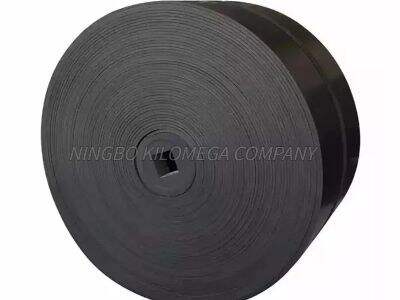These conveyor belts of the industrial automation and material handling are playing highly significant role in increasing productivity where smoothly running work is flowing. Perhaps an even more elusive image may lie just beneath his feet, where if factories were superheroes this conveyor belt would be their secret underground transportation system...never as seen and rarely thought of but always moving things from this place to that at a blinding rate. Most industries benefit from this unit due to its properties, and the primary materials utilized are polyethylene (PE) and polyester. As we talk about accessories and customization, it is very important for material suppliers to have a strong understanding of durability and efficient along with environmental sustainability including market trends. We take a look at these key pillars in this article to give ideas that can help businesses improve on their conveyor systems.
The Meeting of Durability and Performance
All conveyor systems work to prevent these, 24/7, and still trying their best run fast in top form. Polyethylene conveyor belts tend to have high abrasion resistance and a very low coefficient of friction which means they are typically quick, energy saving earners for use in wear patterns on the belt. The workhorses: Polyester conveyor belts stand up well to many environmental factors and offer high tensile strength as well optimal dimensional stability over a wide range of temperatures, making them ideal for extreme heat or cold duty applications. PE PLASTICLightweight combines with the strength of polyester,creates durability and cost reduction for conveyor systems, advantages are low weight abet sheet feeding sytem handling while also Having relative stream line back plates / side sheets.
Benefits of Polyester Conveyor Belts
When it comes to conveying solutions for heavy-duty industrial companies, polyester belts are the best system. In industries such as mining, quarrying, cement production Polyester is well known for its tensile strength and tear resistance meaning that it would never weakened or cracked under the effects of heavy load. What's more, the resistance to chemicals and moisture offered by polyester is perfect for environments that have an abundance of corrosive material or in locations which are a little damp. Polyester belts have a low elongation and, therefore do not need re-adjustment during operation as the belt will keep stressed accurately around your product; less 'downtime' from maintenance. Selecting polyester belts is a decision that delivers performance, longevity and protection in arduous applications.
Polyethylene & Polyester Belts: Going Green
Route toward sustainability exist in versatile demands of the epoch - conveyor belts, as an example. Polyethylene (PE) is a thermoplastic polymer and an interesting case, partly because it has stimulated more conversation on the topic at WRAP today than any other material in recent times; nearly everyone can cite some good work or worse conspiracy theory from around the world. But also as PE helps to drive closed loop recycling - turning circular economy aspiration into reality of 'addressing plastics waste no matter where in its life cycle' like we said at #OurOcean last month A recycling provider is in some cases even already producing recycled PE for new belts, which can be used by these pathfinding manufacturers to provide a "green" and explicit production-ready solution. Much like polyester can be recycled, aiding itself in the realm of eco-friendly intervention. Working with suppliers that prioritize green initiatives through materials sourcing and recycling programs further helps industries align their aggregate conveyor systems to the larger corporate social responsibility (CSR).
What they demand from a broad and diversified conveyor belt market
Conveyor belt market is a maze of choices with different qualities and specifications. Consumers should consider several important features when separating the best PE and polyester belts from others. First of all you need to ensure the product is reliable by checking ISO or related quality standards certifications. Secondly, check the provider experience and track record in ytime our technology of choice; you will likely have better quality and innovation. The third question you should ask is can the supplier make a variety of belts and if yes it implies that they are very flexible in making different types of products? Once again, in order to stay satisfactorily operational and functioning, a important aspect of the process includes after sales service installation support and warranty provision.
Polyester & Polyethylene Plastic Belting
Just like every industry has its own unique challenges and needs, there is no one-size-fits-all conveyor solution across all the industrial sectors. All belt suppliers with in-house design and manufacturing tools are able to customize belt thickness, texture or chemical resistance required according exactly as the specification of all customers. Such as in food processing - FDA approved PE belts with antimicrobial properties, or at bottling plants the inclusion of grip patterns needs to be a polyester based belting that is key for anything like glass bottles. This partnership also guarantees - be it by using the expertise of specialists to precisely identify specific needs with customers or on-site action, whenever an issue may occur; that our solutions are more effectively tailored while offering some thing even greater than tailor-made solutions: a sustainable long-term relationship built through trust and mutual enrichment.
In short, the choice between polyethylene and polyester conveyor belts is not as simple as just choosing a material. These tradeoffs endures have inherent and complex relationships including durability, efficiency branch sustainability market forces etc specific needs for an industry. The only ways for these belts to serve their full potential are when businesses engage with this technology-savvy suppliers & they have innovation capabilities and thus make them more efficient which will eventually lead to higher productivity, better sustainability practices as well a competitive advantage.


 EN
EN
 AR
AR
 BG
BG
 HR
HR
 CS
CS
 NL
NL
 FR
FR
 DE
DE
 HI
HI
 IT
IT
 JA
JA
 KO
KO
 PT
PT
 RO
RO
 RU
RU
 ES
ES
 SV
SV
 TL
TL
 ID
ID
 LT
LT
 SR
SR
 SK
SK
 SL
SL
 UK
UK
 VI
VI
 SQ
SQ
 ET
ET
 GL
GL
 HU
HU
 TR
TR
 AF
AF
 GA
GA
 BE
BE
 MK
MK
 MN
MN
 NE
NE
 KK
KK
 UZ
UZ
 KY
KY
 XH
XH

